However, before this game was created, similar ones were played by the noble and the high class
by using sea shells, on which a text was painted. This was Uta Awase ("poem combining"),
in which half poem was written on one shell, and the remaining verses on a second shell, which
in the game had to be correctly matched with the former one.

HEN - TSUKURI KARUTA
Somewhat controversial is the historical record of
Hen-Tsukuri Karuta, a card game
based on Chinese/Japanese characters, mentioned by a very limited number of
sources.
In average glyphs, the hen or radical is
very often the left part,
which conveys a basic concept (e.g. "water", "tree", "ground", etc.), while the
tsukuri is the right part, which defines the glyph's final and more specific meaning (e.g.
from "water"à"sea", "to wash",
"pond", etc., or from "ground"à"place", "land",
"castle", or from "tree"à"willow", "board",
and so on).
A Hen-Tsukuri Karuta deck may contain a variable number of
cards; no less than 100-120 different are needed for a standard game.
The main goal is to form existing characters by matching cards, as
shown in the simplified diagram on the right. |
|
 |

each subject may be used either as hen or as tsukuri |
Hen-Tsukuri Karuta was played during the Edo period (17th to mid 19th century), when
it was rather popular. Despite the original game should be considered obsolete,
nowadays several modern editions based on a similar principle have been placed
on the market, although both the cards and the rules often slightly differ from
the classic version. |
The edition shown above and on the right, officially
called Kanji-Hakushi ("Chinese character expert", by Okuno Karuta, Japan),
has rules very similar to the original game: there are 125 cards, which may be used
either as hen or as tsukuri, and
the players take turns in picking the covered ones from a pile, and arrange
them either horizontally or vertically, so to form glyphs
made of two or even three cards, as shown in the picture.
Hen-Tsukuri Karuta, or its modern versions, may be compared to
the Western game of Scrabble or, even closer, to the card game
called Lexicon (see page 2). |

a few sample combinations |
 |
|
 |
| UTA KARUTA |
AND |
SHIMO-NO KU KARUTA |
the Uta Karuta samples feature the same subjects taken from a hand-painted mid 18th century deck
(in the Fournier Museum, Spain) and from two modern editions by Nintendo and Ôishi Tengudo (Japan);
the Shimo-no Ku Karuta samples come from a modern edition by Nintendo

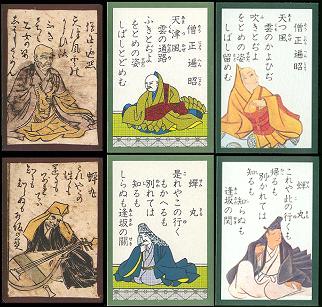
each row features the same yomifuda from
an early deck (left) and from two modern editions |
Uta Karuta ("poem cards"), or simply Karuta ("cards"), also known in the West as "100-poet cards", is a traditional non-gambling game, enjoyed throughout Japan especially on New Year's Day; even schools often hold tournaments.
The two hundred cards in the set feature short Japanese
compositions, from a classic anthology of one hundred poems called  Hyaku-nin Isshu Hyaku-nin Isshu ("one lyric by one-hundred authors"). The anthology was compiled in the 13th century, from earlier works. Each of the one hundred poems, whose themes are love, the seasons, and several other subjects, is by a different author. Their traditional style is called  tanka tanka ("short song") or, in ancient times,  waka waka ("harmonious poem"): each composition consists of five verses only, for a total of thirty-one syllables.
|
One half of the deck shows Japanese personages, wearing traditional clothes, with the full poem in small characters above them: these are called
 yomifuda
yomifuda,
or "reading cards".
The remaining one hundred subjects (picture below) are not illustrated, but feature a shorter and larger text: the last two verses of the aforesaid poems. These ones are called
 torifuda
torifuda ("grabbing cards"), because players have to get hold of them during the game.
The pattern of the
Uta Karuta set is very traditional, as shown by the comparison between present editions and sets over two centuries old: the poems and the illustrations remained basically unchanged.
The exact date of origin of the game is uncertain; it was first reported in the 17th century, and sets similar to the ones produced today already existed by the second half of the 18th century, although up to the late 1800s they were painted by hand, thus much less affordable for the general public.
The personages that appear in each yomifuda card are the one hundred poets included in the anthology, i.e. the actual authors of the verses. Their names are spelt in the top right corner of each subject, before the text of their lyric (as shown in the previous picture). Most of the poets are featured sitting in various attitudes, and some of their distinctive deatil attributes (hairstyle, moustache and/or beard, etc.) have been steadily maintained in modern editions. |
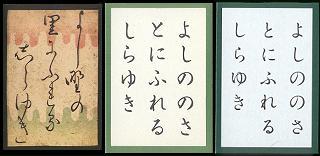
old and modern torifuda, with the last two verses
of one of the poems; they all refer to the same lyric |
 |
In the earliest editions (1600-1750), the only difference was that the reading card (yomifuda) together with the poet's portrait featured only the first half of the poem, not the whole text.
Not only male authors are found in the anthology: quite a few female poets too were included. In early editions some of the women are seen from the back, or partly hidden, probably as a form of modesty, as in the two samples shown below.
Instead the torifuda cards contain nothing but the text; in some editions, particularly old ones, the background may have a decorative texture.
To play Karuta, the two opponents lay torifuda face up. Then a third
person (the game's reader, or judge) picks up one yomifuda, and starts reciting its text; the
goal of the players is to recognize the poem, and grab the corresponding torifuda before the opponent
does so.
the same couplet (yomifuda and matching torifuda) from the
three aforesaid editions: note how the personages look similar |
Needless to say that the best players know all the poems by heart, at the point that they can tell the right card from the very first sound uttered by the reader. Some poems, though, share the same opening syllables, thus make the search more difficult.
The Hyaku-nin Isshu anthology and the related game are so popular in Japan that competitions are regularly held, with both young and elderly participants. Often, the battle for the card that has been
called is almost physical: a vivid description can be read in David Bull's
"KARUTA: SPORT
OR CULTURE?". Pictures of one of these competitions are shown in this other
Karuta page. |
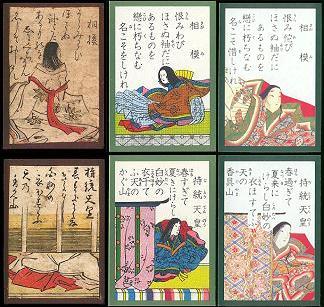
two yomifuda with female poets; in old times
they were often featured turned round, or hidden
|
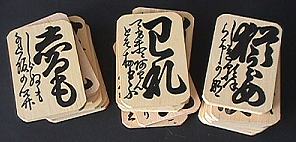 |
In Hokkaido (Japan's northern island) Karuta is
played with a similar set, but the torifuda are slightly larger, and
traditionally made of wood.
In fact, this variety is also called Ita Karuta
("wooden board cards"), but its official name is
Shimo-no Ku Karuta (more or less "cards of
the second half verses"). |
This version was probably born in Kanto (the western area comprising the
city of Tokyo), and then moved further north towards Hokkaido, where its
tradition consolidated.
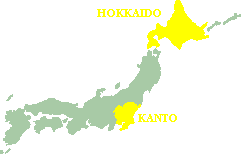
Besides the different material,
the text of these cards (or large tiles, about 5 mm or ¼ inch thick) is featured
in a particular hand-written calligraphic style, with the opening characters larger
than the following ones, for an easier reference in play.
The yomifuda, instead, are identical to the standard ones, although in
some editions, such as the one shown in this page, they do not feature the
portrait of the relevant poet, but have a plain white background.
Despite its regional origin, a national society of Shimo-no Ku Karuta players
exists. |

two torifuda and matching yomifuda |
Lastly, in a less common version of
Karuta, the double set of cards features verses written by two different authors, a form of poetry known as
 renga
renga. In these editions, the opening lines of the poem, by the first author, are on the
yomifuda, while the second part, by the other author (almost as a reply), is found on the
torifuda.
When the reader calls the first part of the poem, the players must find the closing part.
More about the anthology, the game, and a full list of the poems with parallel translation,
can be found in the OGURA HYAKUNIN ISSHU
page, by "The Japanese Initiative".
OTHER GALLERIES





















or back to

INTRODUCTION
AND HISTORY
|

MULTI-LANGUAGE
GLOSSARY |

THE FOOL &
THE JOKER |

INDEX
TABLE |

REGIONAL
GAMES |

PLAYING CARD
LINKS |